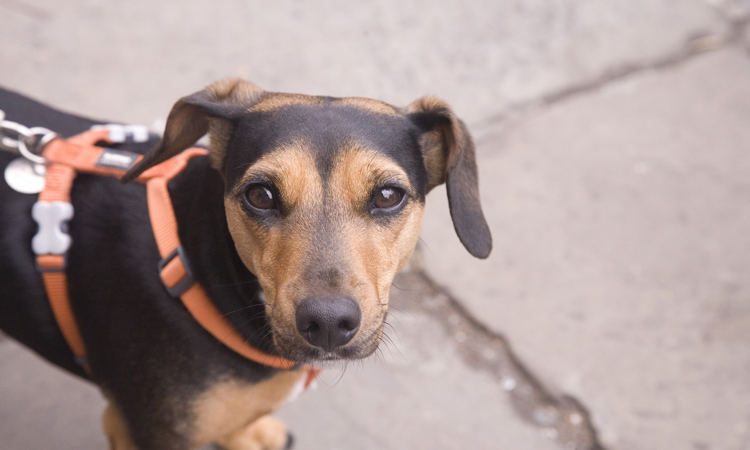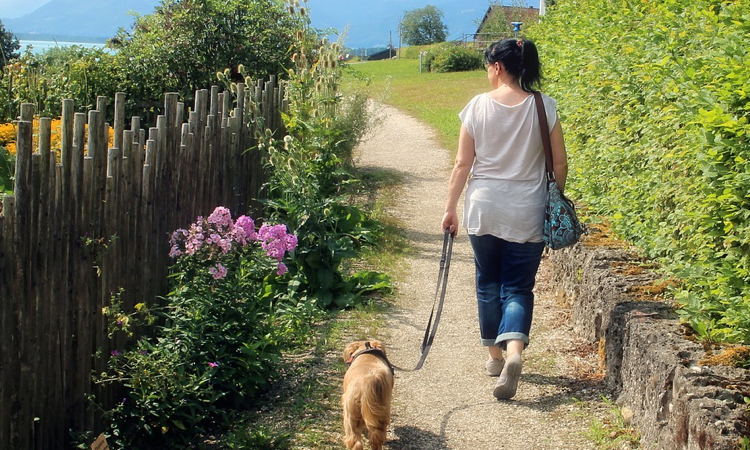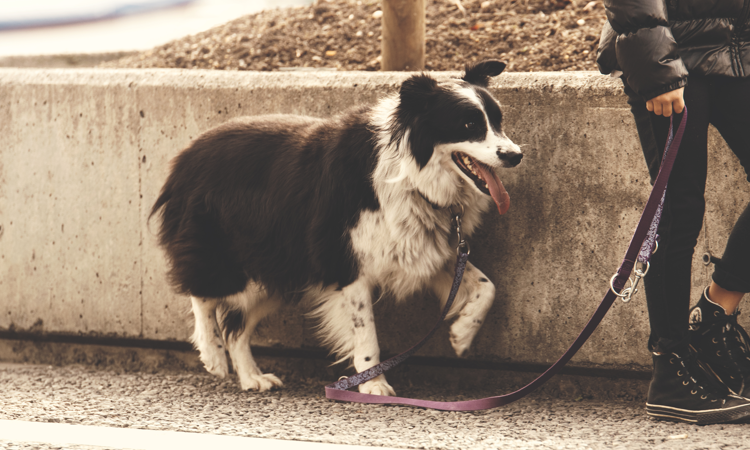Training your dog to walk on the lead will help you and your dog enjoy heading out for walkies, undeniably one of dogs’ all time favourite activities. Some puppies and dogs will wear their collar and lead easily from day one, whereas others may find it more difficult. Walks are exciting for both you and your dog, but a calm and patient approach to lead training will help your dog to build up confidence and get them ready for walking with you.
Getting your dog used to a collar and lead

Practice popping on your dog’s collar during really fun experiences. For example, putting it on just before a great game of fetch, before they are given their dinner or for a trip outside in the car. This will help them to associate it with good things, whilst letting them know it’s nothing to be frightened of and will help distract them so that they forget they’re even wearing it.
Once your dog is used to their collar, try attaching a loose, lightweight lead and letting them run around the house with it on. This helps the dog to feel confident and ensures they don’t view the lead as something they’re instantly going to get tugged around by.
While your dog is wearing the lead, play with them or do some basic training that you know they’ve already mastered. Simple commands like ‘sit’ or ‘paw’ form a good starting point! Give lots of praise and positively reinforce good behaviour or make it fun with a game they can complete with their lead on.
Next, try stepping outside with it on. Take this step super slowly. Some dogs will want to walk straight away whereas some will be more reluctant and the first walk will be a big deal.
If your dog begins to walk with the lead on without fuss, let them go a few steps then praise and treat them down by your heel. This will help them to keep some attention on you during the walk.
If your dog is scared or reluctant to walk never tug them along. Instead, go a few paces forward, call them and then give them a treat when they approach. After a few times of doing this the walk and collar and lead should become much less intimidating.
Take small steps (literally) and build up to bigger ones as your dog becomes more confident and happy on their collar and lead.
Train your dog to walk on the lead

Getting your dog used to their collar and lead is one thing, but helping them to walk on it is another. A loose lead is much more comfortable and enjoyable for both owners and dogs. It stops you from getting that horrible back or arm ache and ensures you can let your dog explore without pulling you for a walk! Here’s how to master the art of the loose lead during a walk.
- Ensure your dog’s collar and lead fits them appropriately. The collar should be snug but with enough room for you to slip two fingers comfortably underneath it. Whereas the lead should be long enough to create a loose arc between you. If the lead is too short, there won’t be enough slack in it for either of you to make a loose lead, so set your dog up for success first and foremost. Don’t use a long line or extendable lead for training as these are too hard to control.
- Go to a quiet area, a secluded park or your own garden, and practice walking in slow, smooth circles with your dog. If they bend to sniff something but aren’t tugging on the lead, let them do this for a few seconds, then move on again giving a cue such as “let’s go”.
- If your dog pulls on the lead, stand completely still and wait. Eventually, your dog should let the lead go slack again or will look at your for guidance. When this happens you can praise them with a word such as “good” and give them a small treat.
- Once the lead is slack again, continue to walk. Remember, it may take time for your dog to realise that a loose lead and no pulling equals walking so be patient.
- Keep practicing this in a quiet, calm environment before taking it outside. The more exciting or new the environment, the more likely your dog is to want to pull in it. Keep sessions short and use other exercise (such as fetch or hide and seek indoors) to wear out your dog while they’re getting the hang of things.
- With lots of practice, your dog will learn that a loose lead is essential to them getting to explore exciting new environments. Once they have got the hang of it, you can reduce the treats and praise to every now and again, helping to reinforce that a loose lead is good.
Train your dog to heel

Remember, heel is a different skill to walking nicely on the lead. With heel training, the goal is to get your dog to walk at your side, both on on and off the lead. Both heel and walking on the lead are great skills but should be taught separately – asking your dog to heel and walk on a loose lead can be tricky to get right, for you and your dog because using on-lead training methods can lead to lots of correction and unhappy dogs and tired dog owners.
Training your dog to heel (whether on or off lead) is a great skill that will help them in many situations. Here’s how you can teach it:
- Start by practising off lead and in your home or garden. Gather a selection of small, tasty treats in your pocket and call your dog. When they come over, reward them and then begin walking slowly around the room with a few treats in your hand.
- They should sense that treats are near and will likely begin to follow you around.
- When your dog stays near to your heel give them praise and bend down to reward them. It’s important that they are treated while still in the heel position, rather than away from you or jumping up.
- Once they are reliably following your heel, begin to introduce a command such as “heel” or “close now”. If they continue to heel after the command, give them a treat and praise them.
- Now begin to spread the distance between treats. For example, try to get up to three or four paces with your dog still heeling. Reward your dog every four or five steps and then gradually build up to a higher amount.
- Now practice saying “heel” and see if your dog comes over to your heel. If they do, give them a treat and praise them, then say it again and begin to walk around the room again, giving them treats and praise as you go.
- Once this behaviour is reliably working indoors, practice in short sessions outside or while off the lead. With practice, your dog should return to your heel and walk with you, whether they are on or off lead.
Can your dog walk on the lead? What training tips did you find most effective? Share your dog training stories on Facebook, Twitter or in the comments below.